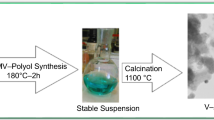Abstract
Zinc oxide is a widely used white inorganic pigment. Transition metal ions are used as chromophores and originate the ceramic pigments group. In this context, ZnO particles doped with Co, Fe, and V were synthesized by the polymeric precursors method, Pechini method. Differential scanning calorimetry (DSC) and thermogravimetry (TG) techniques were used to accurately characterize the distinct thermal events occurring during synthesis. The TG and DSC results revealed a series of decomposition temperatures due to different exothermal events, which were identified as H2O elimination, organic compounds degradation and phase formation. The samples were structurally characterized by X-Ray diffractometry revealing the formation of single phase, corresponding to the crystalline matrix of ZnO. The samples were optically characterized by diffuse reflectance measurements and colorimetric coordinates L*, a*, b* were calculated for the pigment powders. The pigment powders presented a variety of colors ranging from white (ZnO), green (Zn0.97Co0.03O), yellow (Zn0.97Fe0.03O), and beige (Zn0.97V0.03O).



Similar content being viewed by others
References
Martos M, Martínez M, Cordoncillo E, Escribano P. Towards more ecological ceramic pigments: study of the influence of glass composition on the colour stability of a pink chromium-doped ceramic pigment. J Eur Ceram Soc. 2007. doi:10.1016/j.jeurceramsoc.2007.03.030.
Cho S, Jung S-H, Lee K-H. Morphology-controlled growth of ZnO nanostructures using microwave irradiation: from basic to complex structure. J Phys Chem. 2008. doi:10.1021/jp803783s.
Singh S, Rama N, Sethupathi K, Rao RMS. Correlation between electrical transport, optical, and magnetic properties of transition metal ion doped Zn. J Appl Phys. 2008. doi: 10.1063/1.2834443.
Zhang W-H, Zhang W-D, Zhou J-F. Solvent thermal synthesis and gas-sensing properties of Fe-doped ZnO. J Mater Sci. 2010. doi:10.1007/s10853-009-3920-y.
Ghoshal T, Biswas S, Paul M, De SK. Synthesis of ZnO nanoparticles by solvothermal method and their ammonia sensing propertie. J Nanosci Nanotechnol. 2009. doi:10.1166/jnn.2009.1290.
Lavat AE, Wagner CC, Tasca JE. Interaction of Co–ZnO pigments with ceramic frits: a combined study by XRD, FTIR and UV–visible. Ceram Inter. 2008. doi:10.1016/j.ceramint.2007.09.003.
Gaudon M, Toulemonde O, Demourgues A. Green coloration of co-doped ZnO explained from structural refinement and bond considerations. Inorg Chem. 2007. doi:10.1021/ic701157j.
Lima RC, Macario LR, Espinosa JWM, Longo VM, Erlo R, Marana N, Sambrano JR, dos Santos ML, Moura AP, Pizani PS, Andrés J, Longo E, Varela JA. Toward an understanding of intermediate- and short-range defects in ZnO single crystals. A combined experimental and theoretical study. J Phys Chem. 2008. doi:10.1021/jp8022474.
Pechini M. Method of preparing lead and alkaline—earth titanates and niobates and coating method using the same to form a capacitor. US Patent 3,330,697. 1967.
Kakihana M. Invited review “sol–gel” preparation of high temperature superconducting oxides. J Sol–Gel Sci Technol. 1996. doi:10.1007/BF00402588.
Araújo VD, Bernardi MIB. Synthesis and optical and structural characterization of Ce(1−x)O2:M x O (M = Cu, Co) pigments. J Therm Anal Calorim. 2010. doi:10.1007/s10973-010-0892-8.
CIE. Recommendations of uniform color spaces, color difference equations, phychometrics color terms. Supplement no. 2 of CIE Publ. Nº. 15 (E1e1.31) 1971, Bureau Central de la CIE, Paris; 1978.
Matteucci F, Cruciani G, Dondi M, Gasparotto G, Tobaldi DM. Crystal structure, optical properties and colouring performance of karrooite MgTi2O5 ceramic pigments. J Solid State Chem. 2007. doi:10.1016/j.jssc.2007.08.029.
Dondi M, Matteucci F, Cruciani G, Gasparotto G, Tobaldi DM. Pseudobrookite ceramic pigments: crystal structural, optical and technological properties. Solid State Sci. 2007. doi:10.1016/j.solidstatesciences.2007.03.001.
Bernardi MIB, Araújo VD, Mesquita A, Frigo GJM, Maia LJQ. Thermal, structural and optical properties of Al2CoO4-Crocoite composite nanoparticles used as pigments. J Therm Anal Calorim. 2009. doi:10.1007/s10973-009-0164-7.
Vogel AI. Textbook of macro and semimacro qualitative inorganic analysis, 5th edn. London: Longman; 1979. p. 527.
Roosendaal SJ, Bakker JPR, Vredenberg AM, Habraken FHPM. Passivation of iron in H2O an O2/H2O mixtures. Surf Sci. 2001. doi:10.1016/S0039-6028(01)01325-5.
Fernandes DM, Silva R, Hechenleitner AAW, Radovanovic E, Melo MAC, Pineda EAG. Synthesis and characterization of ZnO, CuO and a mixed Zn and Cu oxide. Mater Chem Phys. 2009. doi:10.1016/j.matchemphys.2008.11.038.
Naeem M, Hasanain SK, Mumtaz A. Electrical transport and optical studies of ferromagnetic Cobalt doped ZnO nanoparticles exhibiting a metal-insulator transition. J Phys Condens Matter. 2008. doi: 10.1088/0953-8984/20/02/025210.
Shannon RD. Revised effective ionic radii and systematic studies of interatomie distances in halides and chaleogenides. Acta Cryst. 1976;A32:751–67.
Acknowledgements
The authors also gratefully acknowledge the financial support of the Brazilian research funding agencies FAPESP, CAPES, and CNPq.
Author information
Authors and Affiliations
Corresponding author
Rights and permissions
About this article
Cite this article
Milão, T.M., Oliveira, J.F.A., Araújo, V.D. et al. Zn0.97M0.03O (M = Co, Fe, and V) pigments: thermal, structural, and optical characterization. J Therm Anal Calorim 103, 873–877 (2011). https://doi.org/10.1007/s10973-010-1107-z
Received:
Accepted:
Published:
Issue Date:
DOI: https://doi.org/10.1007/s10973-010-1107-z



